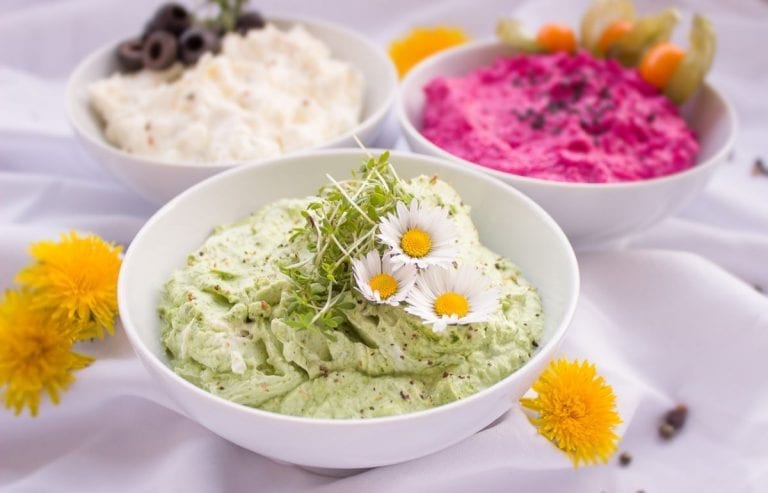Labeling them as simple ornaments would be really reductive: edible flowers have many other advantages in addition to aesthetics, although they are often used by chefs to enliven food with a touch of colour and to enhance the presentation of showy dishes. In reality, with the exception of experts in the sector, few know that their flavour varies from species to species, just like with vegetables; it's therefore necessary to carefully select the types used in the kitchen, following seasonal cycle and relying on producers who can provide useful information regarding the conservation and transformation of the product. The Antea project is based on this premise, an Italian-French initiative promoted by Crea (the Council for research in agriculture and the analysis of the farming economy) and financed by the European Regional Development Fund (ERDF), with the intent of creating an experiment, research, communication and training network relating to floriculture.
Edible flowers. The objectives of Crea
According to the most recent statistics, in the last 5 years cultivation and trade of edible flowers have grown dramatically, thanks to the tendency of haute cuisine to exploit the potential of such ingredients of discreet charm and numerous beneficial effects for human health. The development of the supply chain, however, is still in infancy stages and requires targeted aid to evolve in the right direction. In this sense, the Antea project has decided to offer its support to small and medium-sized enterprises in the area (both agricultural and dining businesses), studying sustainable business models for production, quality and safety control, transport and the sale of floral species for food use. Among the researchers' objectives is also introducing a certified brand guaranteeing to customers the traceability of flowers and the creation of a virtual marketplace to promote the activity of companies located in areas (rural or mountain) that are difficult to access by the public. In the meantime, Crea has involved over 40 chefs in Italy and France in the development of recipes designed to enhance the characteristics of the most common types of blossoms.
Edible flowers: how to use them in the kitchen? The word to the chefs
Cooperation between chefs and scholars has paid off: on the Antea website is the recently published free ebook Flowers from the soil to the plate, which in addition to a rich catalogue dedicated to the classification of floral species, contains more than 60 Italo-French recipes, from appetizers to cocktails, complete meal dishes and puddings. A manual that's accessible to all, which dispels the myth of the exclusive use of edible blossoms only by high-ranking cooks and provides valuable advice to anyone who wants to introduce them into their daily diet. Chef Francesco Oberto of Ristorante da Francesco in Cherasco, for example, proposes a snail salad with guacamole, in which the acidity of petals of marigold and verbena balances the fattiness of the butter that characterises the dressing of the stewed snails. Scilla Carilli of Agriturismo Le Germandine in Suvereto, on the other hand, thought of a ricotta cream scented with rose syrup. "It has very ancient origins,'' the chef explains. "It was once prepared by monks and nuns in the province of Livorno. The first written records that attest to its existence date back to 1484." Cocktails are equally interesting, such as the Butterfly Sour with chrysanthemum designed by bartender Fabrizio Tozzi of Giacomo Arengario in Milan, who observes: "The maximum expression of the cocktail is the perfect balance between perfume, colour and taste. All this can be found in nature, in flowers."
Edible flowers: a concentrate of taste and health benefits
If properly paired with food, edible flowers can enhance even the simplest dishes, because "they contain all the stimuli perceived by the five senses: beauty, flavour, aroma, texture and crunchiness," observes Barbara Ruffoni, researcher at Crea Olivicoltura, Frutticoltura e Agrumicoltura body. Plus, unexpectedly, they don't always have the same taste: they can be bitter, sour and savoury depending on the species and cultivation techniques.
From a nutritional standpoint, furthermore, they are an excellent source of minerals, protein and vitamin A and C. Antioxidant content is also noteworthy, due to the presence of flavonoids and carotenoids, which determine the colour of the petals (purple in the former case, orange or red in the latter). All good reasons to bring them to the table. Considering that, also, the eye wants its share!
Antea project - www.interregantea.com
by Lucia Facchini


 Wine promotion, vineyard uprooting, and support for dealcoholised wines: the European Commission's historic compromise on viticulture
Wine promotion, vineyard uprooting, and support for dealcoholised wines: the European Commission's historic compromise on viticulture A small Sicilian farmer with 40 cows wins silver at the World Cheese Awards
A small Sicilian farmer with 40 cows wins silver at the World Cheese Awards Women are the best sommeliers. Here are the scientific studies
Women are the best sommeliers. Here are the scientific studies Where to eat at a farm stay in Sicily: the best addresses in the Provinces of Trapani, Palermo, and Agrigento
Where to eat at a farm stay in Sicily: the best addresses in the Provinces of Trapani, Palermo, and Agrigento Wine in cans, bottle-fermented, and alcohol free: the unstoppable change in Gen Z’s tastes
Wine in cans, bottle-fermented, and alcohol free: the unstoppable change in Gen Z’s tastes






